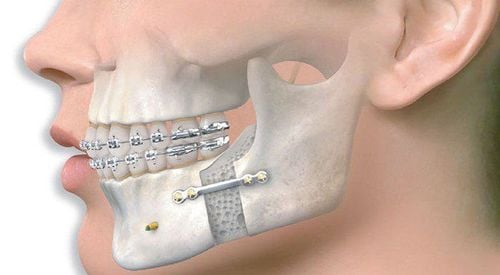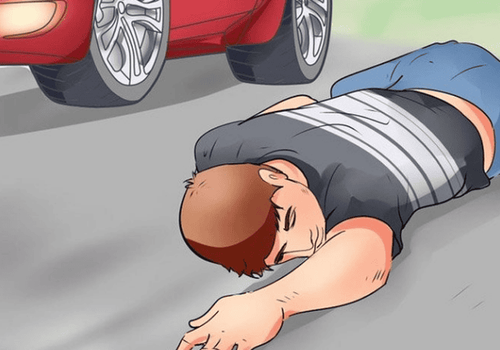This is an automatically translated article.
Stiffness of the knee in the extension or flexion position is a condition that limits the flexion range of the knee joint. The state of not being able to straighten the leg or not to fully bend the leg can be encountered after trauma, after surgery... and to any degree, the loss of knee extension greatly affects the patient's quality of life.
1. Causes of loss of flexion and loss of extension of the knee joint
Knee extension involves a complex musculoskeletal-joint system, specifically the quadriceps muscle attaches to the patella while the patella connects to the tibial tuberosity through the patellar tendon. Excessive flexion of the knee while the quadriceps muscle is still contracted will cause damage to these structures leading to: quadriceps tendon rupture, patellar tendon rupture, tibial tuberosity fracture, and patellar fracture. In healthy individuals, these structures require considerable force to injure, especially as the tendon system is usually very strong, so the patella tends to fracture before the tendon ruptures.
However, the following groups of people are at high risk of tendon rupture including: advanced age, osteoarthritis, use of certain medications (fluoroquinolones, corticosteroids), diabetes, obesity, hyperparathyroidism hypothyroidism, polyneuropathy, drug abuse with steroid-like effects. While injuries often result from minor trauma, the quadriceps tendon tends to be much more susceptible to injury than the patellar tendon, especially in older adults.
Injuries to the ligaments of the knee joint (broken, torn) during sports, traffic accidents, work accidents or falls in daily life... cause the knee cannot be bent.
On the other hand, the patients after reconstruction of the anterior cruciate ligament were able to do most of the daily activities (such as walking, flexing the knees, climbing stairs, etc.) at more than 4 months. after surgery. At this point, the knee is almost fully flexed, but if the patient still cannot straighten the leg or the leg cannot be fully flexed, it means:
The knee joint has a lot of fibrous tissue; Or the ligaments are not placed properly, causing loss of knee extension and loss of flexion; Or the meniscus is torn but has not been properly treated, causing joint jamming; In some cases, patients do too much exercise, massage, and hot compress after surgery, causing nutritional disturbances, causing swelling of the knee, dull pain and a lot of pain at night.
2. Symptoms associated with loss of flexion and loss of extension of the knee joint
In addition to the inability to straighten the leg or the leg to not be fully flexed, the patient may also experience the following symptoms:
Pain and swelling in the affected area; Patients with complete tendon rupture will not be able to stand, not be able to straighten the leg in the supine position, or not be able to extend the knee in the sitting position; Occurrence of complications such as loss of movement, weakness.

Mất duỗi gối là tình trạng không duỗi thẳng được chân hoặc chân không gập được hết
3. Diagnose the cause of the leg not being straightened or the leg not fully flexed
Diagnostic imaging techniques:
X-ray; MRI . Examination of the knee joint to identify structural damage:
Fracture of the quadriceps tendon: the patella is palpable downward; Patellar tendon rupture: The kneecap is displaced upward; Transverse patellar fracture: palpable space between 2 broken bones; Examination of ligaments.
4. What to do when the leg cannot be straightened or the leg is not fully flexed?
It can be seen that there are many causes of knee loss of motion, not being able to straighten the leg or not fully flexing the leg, doctors need to examine specifically to detect the right cause and find a thorough treatment for the problem. patient.
Indications for exercise to improve mobility will be guided if necessary after the doctor has correctly diagnosed the cause of the knee loss of motion, inability to straighten the leg or the leg not fully flexed. Therefore, when this condition occurs, the patient should go to a reputable orthopedic clinic for an accurate examination.
Surgical methods to treat injuries of the knee extensor mechanism are indicated when necessary: JUDET knee stiffness surgery is indicated when the knee stiffness affects the patient's daily activities, amplitude The knee flexion is less than 60 degrees or the patient has an amplitude greater than 60 degrees but needs to improve the knee flexion amplitude.
With the continuous development of scientific progress, Vinmec International General Hospital has successfully implemented and applied many surgeries, orthopedic injuries, rehabilitation of musculoskeletal diseases, in There is an artificial shoulder replacement technique. In particular, with modern technical facilities, there is a team of qualified doctors who are well-trained at major Orthopedic Trauma Centers in the country as well as intensively trained in Joint Replacement, Endoscopy. Joint, Orthopedic Trauma Surgery, etc., taught by experts of the Foreign Orthopedic Association, not only help patients recover function quickly, but also limit complications after joint replacement, surgery, ensure the safety and peace of mind for the patient.
Please dial HOTLINE for more information or register for an appointment HERE. Download MyVinmec app to make appointments faster and to manage your bookings easily.













